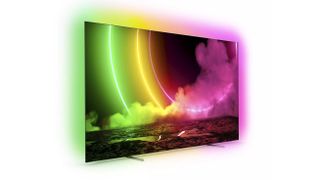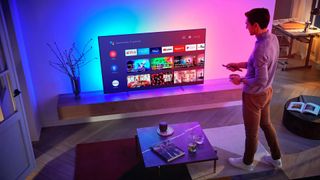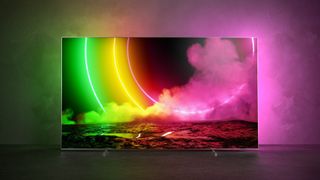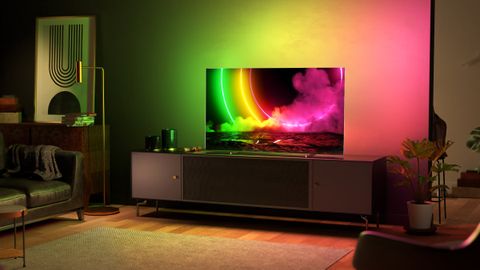TechRadar Verdict
The OLED806 is impressive across the board: the performance/price ratio is as strong as the specification/price ratio, and its Ambilight feature just seals the deal.
Pros
- +
Excellent picture quality
- +
Extensive specification
- +
Relatively hefty, poised sound
Cons
- -
Difficult setup process
- -
Not the slimmest OLED
- -
Android TV interface
Why you can trust TechRadar
One-minute review
With the OLED806, Philips has delivered a good-looking, well-made OLED TV with an absolute stack of functionality, a unique selling point and periodically splendid picture quality. And it’s done all this for a real-world price.
Including every HDR standard isn’t unique - Panasonic does it too - but it certainly makes every other rival look a bit petty. A couple of HDMI inputs with full 2.1 specification is no more than next-gen gamers deserve. And the excellent picture quality - balanced and naturalistic, yet vibrant and exciting at the same time - is augmented by four-sided Ambilight for extra immersion and reduced eye-strain.
The Philips even sounds pretty good.
All of which means the also-ran Android TV interface and intimidatingly in-depth set-up menus can be safely ignored in favour of everything the OLED806 gets right. If it’s in your price range, you simply have to audition it.
Price and availability
The Philips OLED806 is part of Philips 2021 TV range and is on sale now. In the UK, the 55-inch model we’ve got in front of us will set you back £1599. It’s also available in a 48-inch variant (£1299), a 65-inch version (£2299) and a perhaps-unnecessary-but-surprisingly-affordable 77-inch model (£3999).
As far as pricing in America and Australia goes, well, Philips remains cautious in the extreme about the models it launches in those territories. As yet, there’s no confirmation that the OLED806 will make it to either of those markets… mind you, there’s no confirmation that it won’t, either.
Design

Screen sizes (in): 48, 55, 65, 77 | Tuner: DVB-T, T2-HD | 4K: Yes | HDR: HLG, HDR10, HDR10+, HDR10+ Adaptive, Dolby Vision, Dolby Vision IQ | Panel technology: OLED | Smart TV: Android | Dimensions (h x w x d, mm): 706 x 1228 x 68| Weight (kg): 19 | Inputs: HDMI x 4, USB x 3, Ethernet, CI slot, RF and satellite aerial, dual-band wi-fi, Bluetooth 5.0
It’s the usual OLED game of two halves where the design of the Philips OLED806 is concerned.
The first half involves looking at the OLED806 from the dead ahead - which, let’s face it, is how you’ll gaze on it most of the time. From this angle, the Philips is a clean and understated looker, with minimal and tidily finished bezels surrounding the screen. It’s discreet to the point of anonymity - the only branding to be seen is on one of the slender feet on which it stands. In what passes for a design flourish, Philips allows you to fit the feet one of two ways: either with a bright metal finish visible or with a darker, more smoked alternative on view. In either case, the screen sits very low on its feet, which means there’s no way of putting a soundbar between the bottom of the screen and the surface it’s standing on.
The second half means looking at the screen in profile. Philips OLEDs are not alone in being almost supernaturally slim until you reach the point where they keep all their electronic essentials, when they swell to much less glamorous depths. The OLED806 expands to very nearly 7cm - which means it’s far from the most wall-hangable screen around. Still, at least it has some justification for this depth-gain in the form of a unique feature we’ll come to in a moment.
As far as technical specification goes, every significant HDR standard is on board, including HDR10+ Adaptive and Dolby Vision IQ - which is not something the likes of LG, Samsung or Sony can claim for its rival screens - and offers some welcome new touches. The appearance of full-fat HDMI 2.1 compatibility on two of the four HDMI sockets, for example, is overdue - but better late than never, because Philips TVs have plenty to offer next-gen gamers where picture performance is concerned. ARC and eARC capability is available too. There are twin tuners on board, three USB inputs and a few less glamorous inputs as well. Dual-band wi-fi and Bluetooth 5.0 are more than adequate where wireless connectivity is concerned.
Some of that unimpressive chassis depth is mitigated by the appearance of four-sided Ambilight. Even if you’ve never seen it in action, be assured it’s way less gimmicky and way more effective than it sounds. As far as offering a more immersive, less fatiguing viewing experience, and giving the impression of a screen even larger than it is goes, Ambilight is the business. No other TV brand has a USP anything like as compelling.
On the inside, picture quality is governed by the fifth version of Philips’ P5 AI-assisted Intelligent Picture Engine. Philips has long been (in)famous for the thorough-going nature of its picture processing, and here the company has added both Film Detection and Ambient Light aspects to its already impressive AI processing. Film Detection will switch to Filmmaker Mode when content is so flagged (comprehensively spoiling brightness and detail levels in the process) or to Philips’ proprietary (and preferable) Home Cinema Mode if it isn’t. Ambient Light uses the screen’s light sensor to adjust contrast on the fly, depending on - hey! - ambient light levels.

Smart TV (Android TV)
For now, the OLED806 features Android TV (v10) as an operating system. It’s not half-bad by the generally pretty bad standards of Android TV, with a good selection of apps (including Disney+ but not Apple TV) and a layout that’s marginally less infuriating than on previous Android TV interfaces.
It would seem Philips has seen the wisdom of Sony’s move away from Android to Google TV, though - at some unspecified point in the near-to-middle future, the OLED806 will upgrade itself to Google TV. And in the meantime, the unusual combination of Android TV and Freeview Play makes the OLED806 less of an exercise in frustration than it otherwise would have been.
Control is via a fairly large, fairly comprehensive remote control handset that uses a nice slice of Muirhead leather on its rear surface to make it altogether more tactile than any alternative handset from any alternative manufacturer. It puts you in control of set-up menus that are almost wilfully extensive. Philips likes to give the end user a lot of scope to fiddle with the minutiae of picture settings - anyone with even the mildest form of OCD could easily find themselves finessing the numerous available settings for days on end. It is possible to achieve very agreeable picture quality where contrasts, colour fidelity, motion control and so on are concerned quite quickly - and quicker still to ruin it all by having ‘just one more’ investigation of, say, the different ‘Fast Motion Clarity’ settings.
There’s a mic on the remote for use with Google Assistant, and it proves straightforward and responsive to control the OLED806 this way. Although Google Assistant herself seems reluctant to lower its voice even when you’ve asked it to reduce the volume of the TV considerably.
Picture quality
So having finally stopped making infinitesimal adjustments to the set-up menus, it’s time to load up a 4K Blu-ray of Kubrikck’s The Shining (which remains a high watermark where production values and set design are concerned) and find out what the OLED806 has got.
And it doesn’t take long to establish the OLED806 has plenty. It’s talented where virtually every aspect of picture-making is concerned - and even by the standards of Philips (a TV brand that’s been on something of a roll these past few years), it needs remarkably few excuses made for it.
What with this being an OLED panel, we’re entitled to expect clean, deep and lustrous black tones - and, sure enough, that’s what we’re given. But they’re revealing and consistent too, with a deeply impressive amount of detail and variation with them. And they’re complemeted at the other end of the spectrum by clear and equally detailed white tones - the Philips doesn’t use one of the most recent super-bright OLED panels enjoyed by pricier 2021 models from LG and Sony, but it’s capable of punchy and convincing contrasts nevertheless.
Colour fidelity is equally impressive, with an extremely broad palette available and more than enough subtlety to make even the smallest differences in shade or tone obvious. Colours pop when they have to, but they can also be deftly nuanced - even in the same scene. The OLED806 walks the line between ‘natural’ and ‘vibrant’ with more assurance than many alternative OLEDs at this sort of money can manage.

Edges are drawn with real assurance, and it follows that even the most complex patterns (of which this film has plenty) are described without alarms. Shimmer or crawl is basically non-existent, even in tight patterns or complicated textures. The balance the Philips achieves is impressive: sometimes this level of rigour can give images a rather unnatural cast, but the OLED806 looks almost instinctively correct.
Even motion-handling, where in the past Philips has tended to overthink things somewhat, can be finessed until it’s confident, smooth and convincing. We’re not pretending it’s the simplest thing to achieve, any more than we’re pretending it can’t be comprehensively fouled by injudicious use of the set-up menus, but as long as you a) put the time in and b) know when to leave well enough alone, solid and assured tracking of movement is available.
Upscaled 1080p images enjoy all of these positives, although naturally enough with a few caveats. An Amazon Prime Video stream of The Matrix is just slightly coarse when compared to native 4K content, with a little less insight into the darkest tones and a touch more aggression to the way edges and skin-textures are described. But it’s nevertheless a composed, controlled and, above all, watchable performance.
The on-board TV tuners prove perfectly adequate, and even if you indulge in some properly vintage content (anything that’s being broadcast during the day, basically) the OLED806 is capable of upscaling it without softening the picture too badly or loading it too heavily with noise. Televised sport will have you back in those menus to fiddle with motion settings, but (again) there is a very pleasing balance to be struck if you make the effort.
Audio performance
Philips, of course, has lately enjoyed real success with its Bowers & Wilkins collaborations. The OLED806, as the price strongly suggests, hasn’t come in for any B&W fettling - but nevertheless this screen is among one of the more convincing listens available at this sort of money.
The rear-firing driver array generates respectable low-frequency presence. Yes, it’s a bit monotonal, but let’s not be churlish - most TVs don’t even approach the sort of bass the Philips can deliver. The midrange is nicely distinct and projects forward well, which is entirely sensible. And the top of the frequency range is acceptably crisp and fights against hardness, even at volume.
All in all it’s a surprisingly spirited and expansive sound the OLED806 makes - which is just as well, because (as we mentioned) there’s no obvious way to incorporate a soundbar.
Should you buy the Philips OLED806?

Buy it if...
You like value for money
Quite apart from its lovely picture quality, the OLED806 has every HDR standard, some HDMI 2.1 smarts and four-sided Ambilight.
You prefer understated design
There’s nothing shouty about the look of this Philips.
You’d rather do without a soundbar
This is one of the few TVs around that doesn’t include an expensive audio system and yet sounds half-decent.
Don't buy it if...
You want to hang your new TV on the wall
A chassis depth of very nearly 7cm is hardly the last word in modernity.
You want out-of-the-box performance
Philips thinks you should be involved in every aspect of your TV’s picture-making abilities.
You admire a well-sorted smart TV interface
Philips is moving to Google TV soon - but for now you're lumbered with Android TV.
Simon Lucas is a senior editorial professional with deep experience of print/digital publishing and the consumer electronics landscape. Based in Brighton, Simon worked at TechRadar's sister site What HiFi? for a number of years, as both a features editor and a digital editor, before embarking on a career in freelance consultancy, content creation, and journalism for some of the biggest brands and publications in the world.
With enormous expertise in all things home entertainment, Simon reviews everything from turntables to soundbars for TechRadar, and also likes to dip his toes into longform features and buying guides. His bylines include GQ, The Guardian, Hi-Fi+, Metro, The Observer, Pocket Lint, Shortlist, Stuff T3, Tom's Guide, Trusted Reviews, and more.

